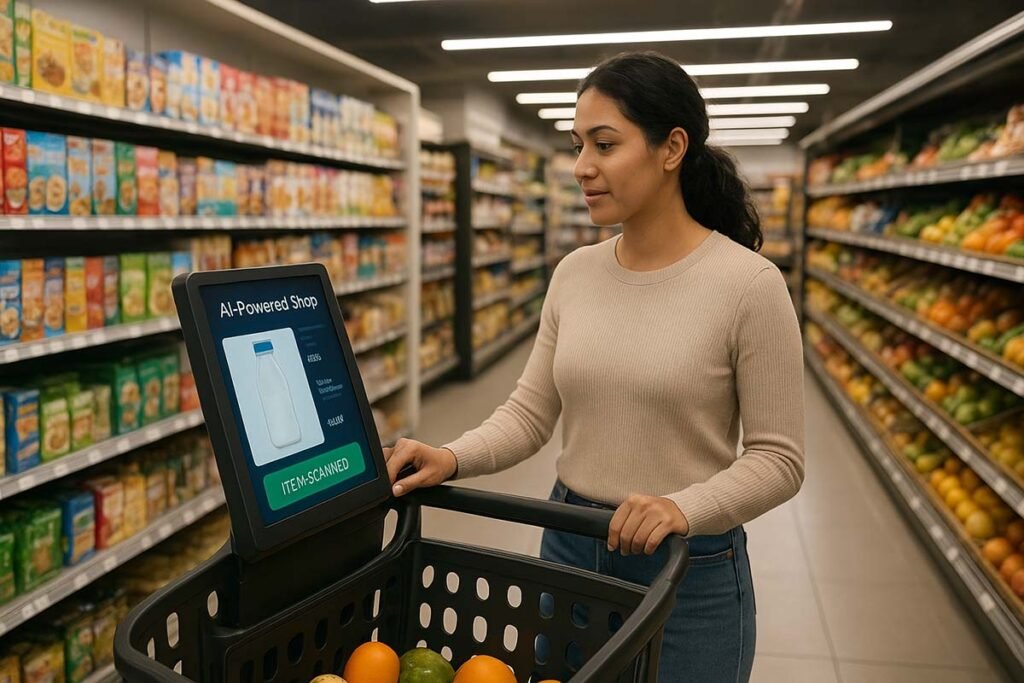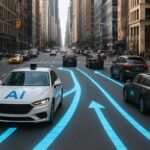The American shopping landscape is undergoing its most significant transformation since the advent of e-commerce. Gone are the days of long checkout lines, empty shelves, and generic shopping experiences. Today, artificial intelligence is revolutionizing how we shop, from the moment we enter a supermarket to the personalized recommendations we receive online.
Consider this: grocery retailers are set to quadruple their AI spending by 2025, while the global AI in retail market has exploded from $11.83 billion in 2024 to a projected $62.64 billion by 2034. This isn’t just about technology adoption—it’s about fundamentally reimagining the entire customer journey. Whether it’s Amazon’s cashierless stores, Walmart’s AI-powered inventory systems, or Target’s hyper-personalized shopping experiences, retailers across America are leveraging artificial intelligence to solve age-old problems while creating entirely new possibilities for customer engagement.
The question isn’t whether AI will transform retail, but how quickly retailers can adapt to stay competitive in this rapidly evolving landscape.
The Current State of AI in US Retail
Market Size and Investment Trends
The United States leads the global charge in retail AI adoption, with the US AI in retail market reaching $3.26 billion in 2024 and projected to hit $18.19 billion by 2034. This represents a compound annual growth rate of 18.76%, significantly outpacing traditional retail growth rates of 1.5% to 3.5%.
Major retailers are making substantial investments in AI technology. Seventy percent of retail executives expect to have AI capabilities in place within 2025 to help personalize experiences, while more than half plan moderate-to-major investments in mergers and acquisitions to accelerate their digital transformation.
Key Drivers Behind AI Adoption
Several factors are fueling this massive adoption of AI in American retail:
Consumer Expectations: American shoppers now expect hyper-personalized experiences, with 89% of business leaders recognizing personalization as invaluable to retail success. The modern consumer demands instant gratification, seamless omnichannel experiences, and products tailored to their specific needs.
Competitive Pressure: With e-commerce giants like Amazon setting benchmarks for speed and personalization, traditional retailers face intense pressure to innovate or risk obsolescence. The pandemic accelerated this shift, with digital grocery sales accounting for 13.2% of total grocery sales year-to-date in 2024.
Labor Challenges: Rising labor costs and workforce shortages have pushed retailers toward automation. AI can help reduce labor costs by up to 20%, while simultaneously improving operational efficiency and customer satisfaction.
Data Availability: The proliferation of smartphones, IoT devices, and digital touchpoints has created unprecedented amounts of consumer data, enabling more sophisticated AI applications.
Supermarket Revolution: Smart Shelves to Autonomous Checkout
Intelligent Inventory Management
Modern supermarkets are becoming data-driven ecosystems where AI algorithms predict demand, optimize stock levels, and minimize waste. Walmart’s AI-powered inventory management system integrates insights from both physical and digital sales channels, enabling the retailer to strategically place products across distribution centers and stores.
Computer vision technology is revolutionizing shelf monitoring. Walmart uses thousands of cameras suspended from ceilings, combined with sensors on shelves, to monitor stores in real-time. These systems can:
- Detect when products are running low and need restocking
- Identify expired or soon-to-expire items for timely removal
- Monitor planogram compliance to ensure optimal product placement
- Track customer interactions with products to optimize layouts
Walmart Canada has introduced computer vision systems designed to identify low stock on shelves and trigger automatic replenishment processes, reducing out-of-stock situations and improving customer satisfaction.
Smart Shopping Carts: The Mobile Revolution
Smart shopping carts represent one of the most promising innovations in grocery retail. Amazon’s Dash Cart and Instacart’s Caper Carts use computer vision and sensors to automatically track items as customers shop. These intelligent carts offer:
- Real-time price tracking and running totals
- Automatic item recognition without manual scanning
- Personalized recommendations based on shopping history
- Gamification features that make shopping more engaging
- Seamless checkout without traditional lines
Caper Carts at ramped locations have achieved a net promoter score of more than 70, with customers often waiting up to 5 minutes for an available smart cart. The technology is particularly popular among families, with children often insisting on scanning items themselves.
Autonomous Checkout: The Future is Here
Cashierless stores represent the pinnacle of retail automation. Amazon Go has expanded to over 170 third-party locations using Just Walk Out technology across the US, UK, Australia, and Canada. The technology has delivered impressive results:
- Market Express at ExCel London increased peak customer service by 300% and annual revenue by 56%
- Lumen Field reported an 85% increase in transactions and a 112% rise in sales
- Delaware North serves 20%-30% more customers in US stadiums
However, the technology faces challenges. Amazon has removed Just Walk Out technology from several Fresh stores, replacing it with Dash Carts, citing customer preference for more control over their shopping experience.
Predictive Analytics and Demand Forecasting
AI-powered demand forecasting is transforming how supermarkets manage inventory and reduce waste. Modern AI systems can analyze historical data, seasonality patterns, weather conditions, and local events to predict demand with 90% accuracy for most SKUs.
Advanced forecasting systems integrate multiple data sources:
- Point-of-sale transactions in real-time
- Market trends and economic indicators
- Customer behavior analytics and sentiment analysis
- Supply chain data including logistics and supplier performance
- External factors like weather patterns and local events

E-commerce Transformation: Personalization at Scale
AI-Powered Personalization Engines
E-commerce personalization has evolved far beyond simple product recommendations. AI-driven personalization can boost conversion rates by 915% and increase average order values by 3%, while AI-powered product recommendations can lead to a 10-30% surge in sales.
Target exemplifies this transformation, leveraging AI to deliver 1:1 personalized content, recommendations, and offers in real-time. The retailer has:
- Enhanced over 100,000 product pages using Generative AI to improve product relevancy
- Implemented AI-driven shopper segmentation leading to a 6.2% increase in conversions
- Developed sophisticated personalization engines that analyze customer data across multiple touchpoints
Voice Commerce and Conversational AI
Voice-activated shopping is gaining significant traction in the US market. 33% of US consumers have used voice assistants like Alexa or Google Assistant to make purchases, with 26.1% of smart speaker owners having tried voice shopping.
The growth trajectory is impressive:
- 16% of smart speaker owners shop monthly by voice, representing a 4.5% increase since 2018
- Voice commerce is projected to account for $40 billion in US consumer spending
- Over half of Google Home smart speaker owners report having tried voice shopping
Visual Search and AR Integration
Augmented Reality and visual search technologies are revolutionizing product discovery. AI-powered visual search allows users to upload or snap pictures to instantly find similar products, bridging the gap between inspiration and purchase.
Virtual try-on technology is transforming fashion and beauty retail:
- The technology uses AI, AR, and computer vision to create realistic product previews
- Customers can visualize how products will look without physical trial
- Early adopters of AR technologies are seeing perceivable increases in customer engagement
Major Retail Players Leading the AI Revolution
Amazon: The Innovation Pioneer
Amazon continues to lead retail AI innovation with its comprehensive ecosystem approach. Amazon Go stores use computer vision, deep learning algorithms, and sensor fusion similar to autonomous vehicles. The company has expanded beyond its own stores, securing over 200 third-party retailers for Just Walk Out technology.
Key Amazon innovations include:
- Just Walk Out technology for cashierless shopping experiences
- Amazon Dash Carts for enhanced grocery shopping
- AI-powered recommendation engines driving personalized experiences
- Predictive analytics for demand forecasting and inventory optimization
Walmart: The Efficiency Optimizer
Walmart has embraced AI as a tool for operational excellence and customer satisfaction. The retailer’s Intelligent Retail Lab uses thousands of cameras and sensors to monitor stores in real-time, enabling:
- Automated inventory management and restocking alerts
- Real-time customer service optimization through queue management
- Supply chain efficiency improvements through AI-driven logistics
- Predictive maintenance for equipment and infrastructure
Target: The Personalization Master
Target has positioned itself as a leader in AI-driven personalization, using machine learning to create highly individualized shopping experiences. The retailer’s AI initiatives include:
- Personalized product recommendations based on comprehensive customer analysis
- Dynamic pricing strategies that respond to market conditions
- AI-driven marketing campaigns with higher conversion rates
- Predictive inventory management to optimize stock levels
Kroger and Regional Grocers
Regional grocery chains are also embracing AI transformation. Kroger has implemented smart shelves and automated checkout systems, while smaller retailers are adopting AI solutions to compete with larger chains.
Consumer Benefits: Enhanced Shopping Experiences
Personalized Shopping Journeys
AI enables retailers to create truly personalized experiences for each customer. 91% of grocers report higher conversions due to improved personalization strategies, driven by:
- Dynamic product recommendations based on individual preferences
- Personalized pricing and promotions tailored to shopping history
- Customized store layouts and product placement optimization
- Targeted marketing messages delivered across multiple channels
Improved Convenience and Efficiency
Modern AI-powered retail delivers unprecedented convenience:
- Reduced wait times through optimized checkout processes
- Accurate inventory information preventing disappointing out-of-stock experiences
- Smart shopping assistance through mobile apps and in-store guidance
- Seamless omnichannel experiences connecting online and offline shopping
Cost Savings and Value
AI helps retailers operate more efficiently, often translating to better prices and promotions for consumers:
- Dynamic pricing that responds to demand and competition
- Optimized promotions based on individual shopping patterns
- Reduced food waste through better demand forecasting
- Improved product availability through predictive restocking
Operational Benefits for Retailers
Cost Reduction and Efficiency Gains
AI implementation delivers significant operational improvements:
- Labor cost reduction of up to 20% through automation
- Inventory optimization reducing carrying costs and waste
- Energy efficiency through smart building management systems
- Predictive maintenance reducing equipment downtime and repair costs
Enhanced Decision-Making Capabilities
AI provides retailers with unprecedented insights into their operations:
- Real-time sales analytics enabling rapid response to trends
- Customer behavior insights driving strategic decisions
- Supply chain optimization reducing costs and improving reliability
- Risk assessment and fraud detection protecting against losses
Competitive Advantages
Early AI adopters gain significant competitive advantages:
- Market differentiation through superior customer experiences
- Operational excellence enabling better pricing and service
- Innovation capabilities attracting tech-savvy consumers
- Scalability allowing rapid expansion and adaptation
Challenges and Limitations
Technical Implementation Hurdles
Despite the promise of AI retail technology, implementation faces significant challenges:
High Initial Investment: Enabling checkout-free experiences requires hefty technology investments, including arrays of cameras, sensors, specialized processing hardware, and cloud infrastructure. For larger store formats, scaling can be quite expensive with costs reaching millions per location.
System Integration Complexity: Retailers must integrate AI systems with existing point-of-sale systems, inventory management, and customer relationship platforms. Compatibility issues may arise during integration, with outdated systems requiring upgrades or replacements.
Accuracy and Reliability: AI and machine learning techniques for retail applications are still at the nascent stage, with results not always accurate. System failures can disrupt the shopping experience and damage customer trust.
Privacy and Data Security Concerns
The extensive data collection required for AI personalization raises significant privacy concerns:
Consumer Privacy Worries: Many consumers are concerned about how their data is used and stored, with the risk of data breaches making people hesitant to embrace AI-powered shopping experiences.
Regulatory Compliance: Retailers must navigate complex privacy regulations like CCPA and GDPR, which require transparency in data collection and allow consumers to opt out of data sharing.
Accessibility and Inclusion Issues
AI-powered retail solutions can inadvertently exclude certain customer segments:
Digital Divide: Checkout-free stores often require smartphones and credit cards, excluding people without these technologies. This particularly affects seniors and lower-income consumers.
Assistance Needs: Senior citizens and differently-abled customers may require assistance that automated systems cannot provide, such as reaching high shelves or carrying heavy items.
Job Displacement Concerns
The rise of autonomous checkout systems has sparked concerns about job displacement in the retail sector. While AI can reduce labor costs, it also raises questions about the social impact of widespread automation on employment.
Future Trends and Predictions
Advanced AI Applications
The next wave of retail AI will bring even more sophisticated capabilities:
Agentic AI: Moving beyond simple chatbots, autonomous agents that can complete entire shopping journeys with minimal human intervention will become more prevalent.
Predictive Shopping: AI will anticipate consumer needs before they arise, automatically reordering essentials and suggesting products based on life events and seasonal patterns.
Hyper-Personalization: Real-time behavioral analysis will enable instant personalization, adjusting store displays, pricing, and recommendations as customers move through physical spaces.
Expanded Technology Integration
Future retail environments will integrate multiple AI technologies:
Computer Vision Evolution: The global computer vision AI in retail market is projected to reach $12.56 billion by 2033, enabling more sophisticated product recognition and customer behavior analysis.
IoT and Edge Computing: Integration of edge computing will facilitate real-time analytics at the store level, minimizing latency and boosting system responsiveness.
Augmented Reality Mainstreaming: AR will become standard in fashion and beauty retail, with virtual try-on technology becoming an expected feature rather than a novelty.
Market Evolution Predictions
Industry experts predict significant changes in the retail landscape:
Digital Grocery Growth: Digital grocery sales are projected to increase by 9.7% in 2025, with the sector potentially becoming the largest ecommerce category in the US by 2026.
Omnichannel Integration: Omnichannel shoppers spend 1.5x more monthly than single-channel shoppers, driving retailers to create seamless integrated experiences.
Retail Media Networks: Retail media is projected to be an $8.5 billion industry in grocery by the end of 2024, as retailers monetize shopper data through targeted advertising platforms.
Conclusion
AI-powered retail represents more than just a technological upgrade—it’s a fundamental reimagining of the shopping experience. From Walmart’s intelligent inventory systems to Amazon’s cashierless stores, American retailers are leading a global transformation that promises to make shopping more convenient, personalized, and efficient than ever before.
The statistics speak volumes about this transformation’s momentum. With grocery retailers quadrupling their AI spending by 2025 and the US AI retail market growing at 18.76% annually, we’re witnessing the birth of a new retail era. Smart shopping carts with 70+ net promoter scores, personalization engines driving 915% increases in conversion rates, and voice commerce approaching $40 billion in annual spending demonstrate that AI isn’t just changing how retailers operate—it’s revolutionizing how consumers shop.
However, success in this AI-driven future won’t be automatic. Retailers must navigate significant challenges, from massive technology investments to privacy concerns and accessibility issues. The winners will be those who can balance technological innovation with human needs, creating experiences that are not just efficient but also inclusive and trustworthy.
As we look toward 2025 and beyond, one thing is clear: the retailers who embrace AI thoughtfully and strategically will not only survive but thrive in America’s rapidly evolving shopping landscape. The question for every retailer isn’t whether to adopt AI, but how quickly they can implement it effectively while maintaining the human touch that keeps customers coming back.
Ready to future-proof your shopping experience? Stay informed about the latest retail AI innovations and discover how these technologies can enhance your next shopping trip—because the future of retail is happening now.
FAQ Section
Q: What is AI-powered retail and how is it changing shopping in the US?
A: AI-powered retail uses artificial intelligence technologies like computer vision, machine learning, and predictive analytics to enhance shopping experiences. In the US, this includes cashierless stores, smart shopping carts, personalized recommendations, and automated inventory management, fundamentally transforming how consumers shop both online and in physical stores.
Q: Which major US retailers are leading the AI transformation?
A: Amazon leads with its Go stores and Just Walk Out technology, Walmart uses AI for inventory management and store monitoring, Target excels in personalization engines, and Kroger implements smart shelves and automated systems. These retailers have invested billions in AI technologies to improve customer experiences and operational efficiency.
Q: How do smart shopping carts work and what are their benefits?
A: Smart shopping carts use computer vision and sensors to automatically recognize items as you shop, display running totals, provide personalized recommendations, and enable seamless checkout without traditional lines. Benefits include reduced wait times, gamified shopping experiences, and integration with loyalty programs and digital coupons.
Q: Are cashierless stores really successful, and what challenges do they face?
A: Cashierless stores show mixed results. Amazon Go has expanded to 170+ locations with impressive metrics like 300% increased customer service and 85% more transactions. However, challenges include high implementation costs, accessibility issues for customers without smartphones, and consumer preference for more control over their shopping experience.
Q: How does AI personalization work in e-commerce shopping?
A: AI personalization analyzes customer data including browsing history, purchase patterns, demographic information, and real-time behavior to deliver customized product recommendations, targeted promotions, dynamic pricing, and personalized marketing messages. This can increase conversion rates by up to 915% and boost sales by 10-30%.
Q: What are the main privacy concerns with AI-powered retail?
A: Key privacy concerns include extensive data collection through cameras and sensors, potential data breaches, unclear data usage policies, and lack of consumer control over personal information. Retailers must comply with regulations like CCPA and GDPR while maintaining transparency about data collection and usage practices.
Q: Will AI in retail eliminate jobs for human workers?
A: While AI can reduce labor costs by up to 20%, it’s more likely to change job roles rather than eliminate them entirely. New positions in AI management, customer service, and technical support are emerging, while traditional roles may evolve to focus on higher-value customer interactions and problem-solving.
Q: What does the future hold for AI in US retail by 2025-2030?
A: The future includes advanced autonomous agents completing entire shopping journeys, hyper-personalized real-time experiences, widespread AR integration, expanded voice commerce reaching $40+ billion annually, and seamless omnichannel integration. The US AI retail market is projected to reach $18.19 billion by 2034.




Pingback: Automotive Revolution: The Role of AI in US Electric & Autonomous Vehicles - FirstsPost